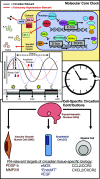A wrinkle in time: circadian biology in pulmonary vascular health and disease
- PMID: 34850650
- PMCID: PMC8759967
- DOI: 10.1152/ajplung.00037.2021
A wrinkle in time: circadian biology in pulmonary vascular health and disease
Abstract
An often overlooked element of pulmonary vascular disease is time. Cellular responses to time, which are regulated directly by the core circadian clock, have only recently been elucidated. Despite an extensive collection of data regarding the role of rhythmic contribution to disease pathogenesis (such as systemic hypertension, coronary artery, and renal disease), the roles of key circadian transcription factors in pulmonary hypertension remain understudied. This is despite a large degree of overlap in the pulmonary hypertension and circadian rhythm fields, not only including shared signaling pathways, but also cell-specific effects of the core clock that are known to result in both protective and adverse lung vessel changes. Therefore, the goal of this review is to summarize the current dialogue regarding common pathways in circadian biology, with a specific emphasis on its implications in the progression of pulmonary hypertension. In this work, we emphasize specific proteins involved in the regulation of the core molecular clock while noting the circadian cell-specific changes relevant to vascular remodeling. Finally, we apply this knowledge to the optimization of medical therapy, with a focus on sleep hygiene and the role of chronopharmacology in patients with this disease. In dissecting the unique relationship between time and cellular biology, we aim to provide valuable insight into the practical implications of considering time as a therapeutic variable. Armed with this information, physicians will be positioned to more efficiently use the full four dimensions of patient care, resulting in improved morbidity and mortality of pulmonary hypertension patients.
Keywords: BMAL1; CLOCK; circadian; pulmonary hypertension.
Conflict of interest statement
No conflicts of interest, financial or otherwise, are declared by the authors.
Figures

References
Publication types
MeSH terms
Grants and funding
LinkOut - more resources
Full Text Sources
Medical

